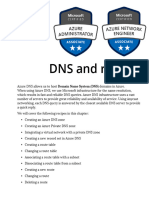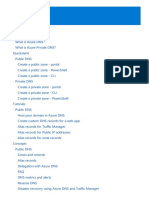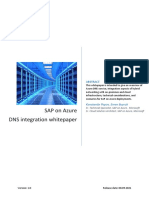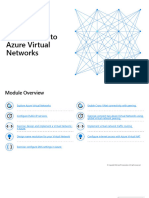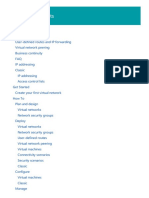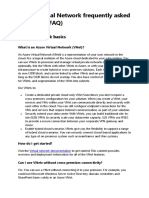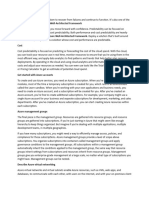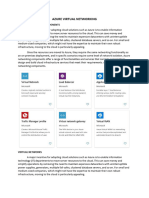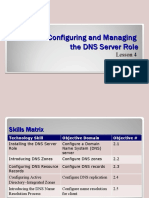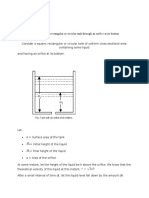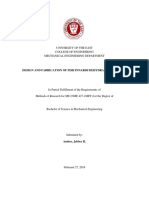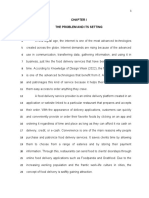Design name resolution for your virtual
network
Depending on how you use Azure to host IaaS, PaaS, and hybrid solutions, you might
need to allow the virtual machines (VMs), and other resources deployed in a virtual
network to communicate with each other. Although you can enable communication
by using IP addresses, it is much simpler to use names that can be easily
remembered, and do not change.
DNS is split into two areas: Public, and Private DNS for resources accessible from
your own internal networks.
Public DNS services
Public DNS services resolve names and IP addresses for resources and services
accessible over the internet such as web servers. Azure DNS is a hosting service for
DNS domain that provides name resolution by using Microsoft Azure infrastructure.
DNS domains in Azure DNS are hosted on Azure's global network of DNS name
servers. Azure DNS uses anycast networking. Each DNS query is answered by the
closest available DNS server to provide fast performance and high availability for
your domain.
In Azure DNS, you can create address records manually within relevant zones. The
records most frequently used will be:
Host records: A/AAAA (IPv4/IPv6)
Alias records: CNAME
Azure DNS provides a reliable, secure DNS service to manage and resolve domain
names in a virtual network without needing to add a custom DNS solution.
A DNS zone hosts the DNS records for a domain. So, to start hosting your domain in
Azure DNS, you need to create a DNS zone for that domain name. Each DNS record
for your domain is then created inside this DNS zone.
Considerations
The name of the zone must be unique within the resource group, and the zone
must not exist already.
The same zone name can be reused in a different resource group or a different
Azure subscription.
� Where multiple zones share the same name, each instance is assigned different
name server addresses.
Root/Parent domain is registered at the registrar and pointed to Azure NS.
Child domains are registered in AzureDNS directly.
Note
You do not have to own a domain name to create a DNS zone with that domain
name in Azure DNS. However, you do need to own the domain to configure the
domain.
Delegate DNS Domains
To delegate your domain to Azure DNS, you first need to know the name server
names for your zone. Each time a DNS zone is created Azure DNS allocates name
servers from a pool. Once the Name Servers are assigned, Azure DNS automatically
creates authoritative NS records in your zone.
Once the DNS zone is created, and you have the name servers, you need to update
the parent domain. Each registrar has their own DNS management tools to change
the name server records for a domain. In the registrar’s DNS management page, edit
the NS records and replace the NS records with the ones Azure DNS created.
Note
When delegating a domain to Azure DNS, you must use the name server names
provided by Azure DNS. You should always use all four name server names,
regardless of the name of your domain.
Child Domains
If you want to set up a separate child zone, you can delegate a subdomain in Azure
DNS. For example, after configuring contoso.com in Azure DNS, you could configure
a separate child zone for partners.contoso.com.
Setting up a subdomain follows the same process as typical delegation. The only
difference is that NS records must be created in the parent zone contoso.com in
Azure DNS, rather than in the domain registrar.
Note
�The parent and child zones can be in the same or different resource group. Notice
that the record set name in the parent zone matches the child zone name, in this
case partners.
It's important to understand the difference between DNS record sets and individual
DNS records. A record set is a collection of records in a zone that have the same
name and are the same type.
A record set cannot contain two identical records. Empty record sets (with zero
records) can be created, but do not appear on the Azure DNS name servers. Record
sets of type CNAME can contain one record at most.
The Add record set page will change depending on the type of record you select.
For an A record, you will need the TTL (Time to Live) and IP address. The time to live,
or TTL, specifies how long each record is cached by clients before being requeried.
�Private DNS services
Private DNS services resolve names and IP addresses for resources and services
When resources deployed in virtual networks need to resolve domain names to
internal IP addresses, they can use one the three methods:
Azure DNS Private Zones
Azure-provided name resolution
Name resolution that uses your own DNS server
The type of name resolution you use depends on how your resources need to
communicate with each other.
Your name resolution needs might go beyond the features provided by Azure. For
example, you might need to use Microsoft Windows Server Active Directory domains,
resolve DNS names between virtual networks. To cover these scenarios, Azure
provides the ability for you to use your own DNS servers.
DNS servers within a virtual network can forward DNS queries to the recursive
resolvers in Azure. This enables you to resolve host names within that virtual network.
�For example, a domain controller (DC) running in Azure can respond to DNS queries
for its domains and forward all other queries to Azure. Forwarding queries allows
VMs to see both your on-premises resources (via the DC) and Azure-provided host
names (via the forwarder). Access to the recursive resolvers in Azure is provided via
the virtual IP 168.63.129.16.
DNS forwarding also enables DNS resolution between virtual networks and allows
your on-premises machines to resolve Azure-provided host names. In order to
resolve a VM's host name, the DNS server VM must reside in the same virtual
network and be configured to forward host name queries to Azure. Because the DNS
suffix is different in each virtual network, you can use conditional forwarding rules to
send DNS queries to the correct virtual network for resolution.
Azure provided DNS
Azure provides its own default internal DNS. It provides an internal DNS zone that
always exists, supports automatic registration, requires no manual record creation,
and is created when the VNet is created. And it's a free service. Azure provided name
resolution provides only basic authoritative DNS capabilities. If you use this option,
the DNS zone names and records will be automatically managed by Azure, and you
will not be able to control the DNS zone names or the life cycle of DNS records.
Internal DNS defines a namespace as follows: .internal.cloudapp.net.
Any VM created in the VNet is registered in the internal DNS zone and gets a DNS
domain name like myVM.internal.cloudapp.net. It's important to recognize that it's
the Azure Resource name that is registered, not the name of the guest OS on the
VM.
Limitations of Internal DNS
Can't resolve across different VNets.
Registers resource names, not guest OS names.
Does not allow manual record creation.
Azure Private DNS Zones
Private DNS zones in Azure are available to internal resources only. They are global in
scope, so you can access them from any region, any subscription, any VNet, and any
tenant. If you have permission to read the zone, you can use it for name resolution.
Private DNS zones are highly resilient, being replicated to regions all throughout the
world. They are not available to resources on the internet.
�For scenarios which require more flexibility than Internal DNS allows, you can create
your own private DNS zones. These zones enable you to:
Configure a specific DNS name for a zone.
Create records manually when necessary.
Resolve names and IP addresses across different zones.
Resolve names and IP addresses across different VNets.
Create a private DNS zone by using the portal
You can create a private DNS zone using the Azure portal, Azure PowerShell, or
Azure CLI.
When the new DNS zone is deployed, you can manually create resource records, or
use auto-registration, which will create resource records based on the Azure resource
name.
Private DNS zones support the full range of records including pointers, MX, SOA,
service, and text records.
Link VNets to private DNS zones
In Azure, a VNet represents a group of 1 or more subnets, as defined by a CIDR
range. Resources such as VMs are added to subnets.
At the VNet level, default DNS configuration is part of the DHCP assignments made
by Azure, specifying the special address 168.63.129.16 to use Azure DNS services.
�If necessary, you can override the default configuration by configuring an alternate
DNS server at the VM NIC.
Two ways to link VNets to a private zone:
Registration: Each VNet can link to one private DNS zone for registration.
However, up to 100 VNets can link to the same private DNS zone for
registration.
Resolution: There may be many other private DNS zones for different
namespaces. You can link a VNet to each of those zones for name resolution.
Each VNet can link to up to 1000 private DNS Zones for name resolution.
�Integrating on-premises DNS with Azure VNets
If you have an external DNS server, for example an on-premises server, you can use
custom DNS configuration on your VNet to integrate the two.
Your external DNS can run on any DNS server: BIND on UNIX, Active Directory
Domain Services DNS, and so on. If you want to use an external DNS server and not
the default Azure DNS service, you must configure the desired DNS servers.
Organizations often use an internal Azure private DNS zone for auto registration, and
then use a custom configuration to forward queries external zones from an external
DNS server.
Forwarding takes two forms:
Forwarding - specifies another DNS server (SOA for a zone) to resolve the query
if the initial server cannot.
Conditional forwarding - specifies a DNS server for a named zone, so that all
queries for that zone are routed to the specified DNS server.
Note
If the DNS server is outside Azure, it doesn't have access to Azure DNS on
168.63.129.16. In this scenario, setup a DNS resolver inside your VNet, forward
�queries for to it, and then have it forward queries to 168.63.129.16 (Azure DNS).
Essentially, you're using forwarding because 168.63.129.16 is not routable, and
therefore not accessible to external clients.



